Citroen C4 CACTUS 2015 1.G Owner's Manual
Manufacturer: CITROEN, Model Year: 2015, Model line: C4 CACTUS, Model: Citroen C4 CACTUS 2015 1.GPages: 326, PDF Size: 8.56 MB
Page 201 of 326
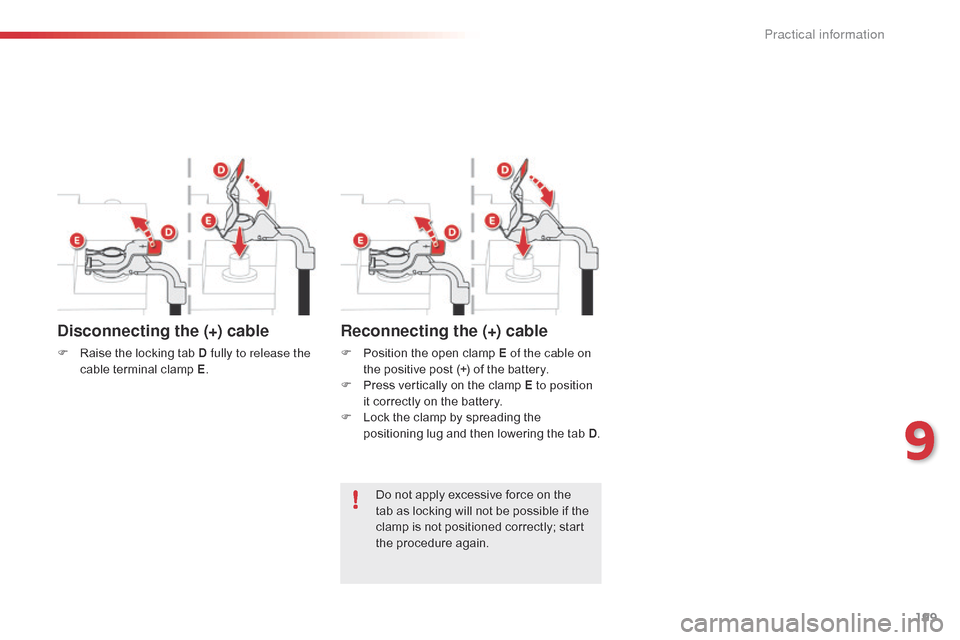
199
C4-cactus_en_Chap09_info-pratiques_ed02-2014
Doô notô applyô excessiveô forceô onô theô tab ô as ô locking ô will ô not ô be ô possible ô if ô the ô
c
lamp ô is ô not ô positioned ô correctly; ô start ô
t
he ô procedure ô again.
Disconnecting the (+) cable
Fô Raiseô the ô locking ô tab ô D fully to release the
cableô t erminalô c lampô E.
Reconnecting the (+) cable
Fô Position ô the ô open ô clamp ô E of the cable on
the ô positive ô post ô (+) ô of ô the ô battery.
F
ô
P
ress ô vertically ô on ô the ô clamp ô E to position
it
ô correctly ô on ô the ô battery.
F
ô
L
ock ô the ô clamp ô by ô spreading ô the ô
p
ositioning ô lug ô and ô then ô lowering ô the ô tab ô D.
9
Practical information
Page 202 of 326
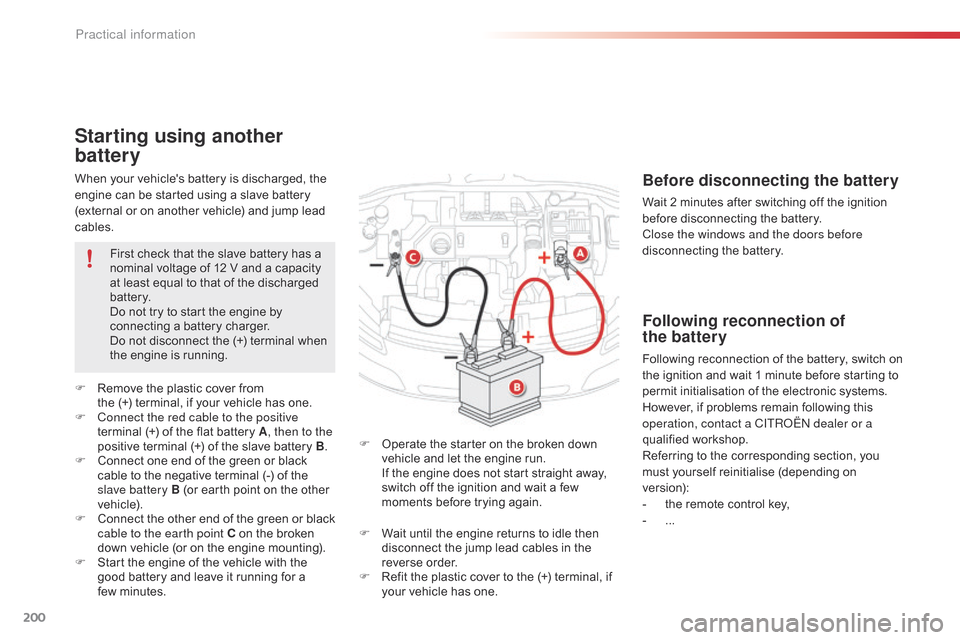
200
C4-cactus_en_Chap09_info-pratiques_ed02-2014
Whenô yourô vehicle'sô batteryô isô discharged,ô theô engine ô can ô be ô started ô using ô a ô slave ô battery ô
(
external ô or ô on ô another ô vehicle) ô and ô jump ô lead ô
c
ables.
Starting using another
battery
Fô Operate ô the ô starter ô on ô the ô broken ô down ô v
ehicle ô and ô let ô the ô engine ô run.
ô I
f ô the ô engine ô does ô not ô start ô straight ô away, ô
s
witch ô off ô the ô ignition ô and ô wait ô a ô few ô
m
oments ô before ô trying ô again.
F
ô
R
emove
ô
the
ô
plastic
ô
cover
ô
from
ô
the
ô
(+)
ô
terminal,
ô
if
ô
your
ô
vehicle
ô
has
ô
one.
F
C
onnect the red cable to the positive
terminal
ô
(+)
ô
of
ô
the
ô
flat
ô
battery
ô
A
, then to the
positive
ô
terminal
ô
(+)
ô
of
ô
the
ô
slave
ô
battery
ô
B.
F
ô
C
onnect
ô
one
ô
end
ô
of
ô
the
ô
green
ô
or
ô
black
ô
c
able
ô
to
ô
the
ô
negative
ô
terminal
ô
(-)
ô
of
ô
the
ô
s
lave battery B
ô
(or
ô
earth
ô
point
ô
on
ô
the
ô
other
ô
v
ehicle).
F
ô
C
onnect
ô
t
he
ô
o
ther
ô
e
nd
ô
o
f
ô
t
he
ô
g
reen
ô
o
r
ô
b
lack
ô
c
able to the earth point C
ô
on
ô
the
ô
broken
ô
d
own
ô
vehicle
ô
(or
ô
on
ô
the
ô
engine
ô
mounting).
F
ô
S
tart
ô
the
ô
engine
ô
of
ô
the
ô
vehicle
ô
with
ô
the
ô
g
ood
ô
battery
ô
and
ô
leave
ô
it
ô
running
ô
for
ô
a
ô
f
ewô minutes. First
ô
check
ô
that
ô
the
ô
slave
ô
battery
ô
has
ô
a
ô
n
ominal
ô
voltage
ô
of
ô
12
ô
V
ô
and
ô
a
ô
capacity
ô
a
t
ô
least
ô
equal
ô
to
ô
that
ô
of
ô
the
ô
discharged
ô
b
attery.
Do
ô
not
ô
try
ô
to
ô
start
ô
the
ô
engine
ô
by
ô
c
onnecting
ô
a
ô
battery
ô
charger.
Do
ô
not
ô
disconnect
ô
the
ô
(+)
ô
terminal
ô
when
ô
t
he
ô
engine
ô
is
ô
running.
Before disconnecting the battery
Waitô 2ô minutesô afterô switchingô offô theô ignitionô b
efore ô disconnecting ô the ô battery.
Close the windows and the doors before
disconnecting
ô the ô battery.
Following reconnection of
the battery
Followingô reconnectionô ofô theô battery,ô switchô onô t
he ô ignition ô and ô wait ô 1 ô minute ô before ô starting ô to ô
p
ermit ô initialisation ô of ô the ô electronic ô systems. ô
H
owever, ô if ô problems ô remain ô following ô this ô
o
peration, contact a CITR
oûn
dealer or a
qualified
ô w
orkshop.
Referring
ô to ô the ô corresponding ô section, ô you ô
m
ust
ô y
ourself
ô r
einitialise
ô (
depending
ô o
n
ô ve
rsion):
-
ô
t
he ô remote ô control ô key,
-
ô ...
F
ô
W
ait
ô
until
ô
the
ô
engine
ô
returns
ô
to
ô
idle
ô
then
ô
d
isconnect
ô
the
ô
jump
ô
lead
ô
cables
ô
in
ô
the
ô
r
everse
ô o
rder.
F
ô
R
efit
ô
the
ô
plastic
ô
cover
ô
to
ô
the
ô
(+)
ô
terminal,
ô
if
ô
y
our
ô
vehicle
ô
has
ô
one.
Practical information
Page 203 of 326

201
C4-cactus_en_Chap09_info-pratiques_ed02-2014
Theô batteriesô containô harmfulô substancesô such ô as ô sulphuric ô acid ô and ô lead. ô Theyô m
ust ô be ô disposed ô of ô in ô accordance
ô w
ith ô regulations ô and ô must ô not, ô in ô any
ô c
ircumstances, ô be ô discarded ô with ô household
ô w
aste.
Take
ô used ô remote ô control ô batteries ô and
ô v
ehicle ô batteries ô to ô a ô special ô collection ô point.Protect your eyes and face before
handlingô the ô battery.
All
ô operations ô on ô the ô battery ô must ô be ô
c
arried out in a well ventilated area and
away
ô from ô naked ô flames ô and ô sources ô
o
f ô sparks, ô so ô as ô to ô avoid ô the ô risk ô of ô
e
xplosion ô or ô fire.
Do
ô not ô try ô to ô charge ô a ô frozen ô battery; ô
t
he ô battery ô must ô first ô be ô thawed ô out ô to ô
a
void ô the ô risk ô of ô explosion. ô If ô the ô battery ô
h
as ô been ô frozen, ô before ô charging ô have ô
i
t ô checked ô by ô a ô CITROûN ô dealer ô or ô a ô
q
ualified ô workshop ô who ô will ô check ô that ô
t
he ô internal ô components ô have ô not ô been ô
d
amaged ô and ô the ô casing ô is ô not ô cracked, ô
w
hich ô could ô cause ô a ô leak ô of ô toxic ô and ô
c
orrosive ô acid.
do n
ot reverse the polarity and use only
a
ô 12 ô V ô charger.
Do
ô not ô disconnect ô the ô terminals ô while ô
t
he ô engine ô is ô running.
Do
ô not ô charge ô the ô batteries ô without ô
d
isconnecting ô the ô terminals ô first.
Wash
ô your ô hands ô after wards.
It is advisable to disconnect the battery
if the vehicle is to be left unused for
more
ô
than
ô
one
ô
month.
If your vehicle is fitted with an electronic
gearbox,
ô do ô not ô push ô the ô vehicle ô to ô start ô
t
he
ô eng
ine.Charging the battery using
a battery charger
Fô Disconnect ô the ô battery ô from ô the ô vehicle.
F F ollow the instructions for use provided by
the
ô manufacturer ô of ô the ô charger.
F
ô
C
onnect ô the ô battery ô starting ô with ô the ô
n
egative ô terminal ô (-).
F
ô
C
heck ô that ô the ô terminals ô and ô connectors ô
a
re ô clean. ô If ô they ô are ô covered ô with ô sulphate ô
(
whitish ô or ô greenish ô deposit), ô remove ô them ô
a
nd ô clean ô them.
With Stop & Start, the battery does not
have
ô to ô be ô disconnected ô for ô charging.
9
Practical information
Page 204 of 326
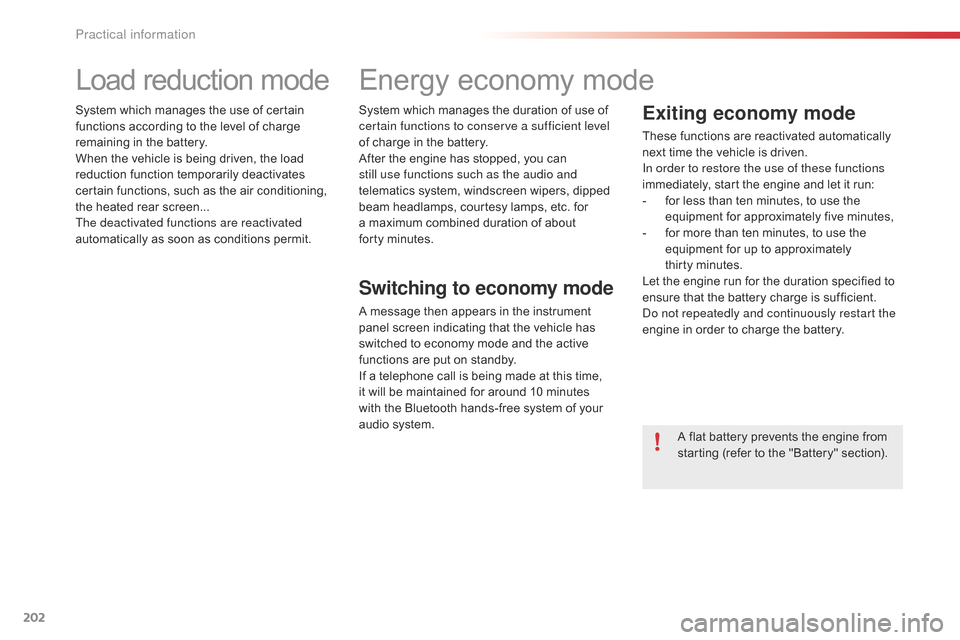
202
C4-cactus_en_Chap09_info-pratiques_ed02-2014
Loadô reductionô mode
Systemô whichô managesô theô useô ofô certainô functions ô according ô to ô the ô level ô of ô charge ô
r
emaining ô in ô the ô battery.
When
ô the ô vehicle ô is ô being ô driven, ô the ô load ô
r
eduction ô function ô temporarily ô deactivates ô
c
ertain ô functions, ô such ô as ô the ô air ô conditioning, ô
t
he ô heated ô rear ô screen...
The deactivated functions are reactivated
automatically
ô as ô soon ô as ô conditions ô permit.System
ô which ô manages ô the ô duration ô of ô use ô of ô c
ertain functions to conserve a sufficient level
of
ô charge ô in ô the ô battery.
After
ô the ô engine ô has ô stopped, ô you ô can ô
s
till use functions such as the audio and
telematics
ô system,ô windscreen ô wipers, ô dipped ô
b
eam ô headlamps,ô courtesy ô lamps, ô etc. ô for ô
a
ô maximum ô combined ô duration ô of ô about ô
f
ortyô minutes.
Energyô economyô mode
Switching to economy mode
Aô messageô thenô appearsô inô theô instrumentô p
anel ô screen ô indicating ô that ô the ô vehicle ô has ô
s
witched ô to ô economy ô mode ô and ô the ô active ô
f
unctions ô are ô put ô on ô standby.
If
ô a ô telephone ô call ô is ô being ô made ô at ô this ô time, ô
i
t ô will ô be ô maintained ô for ô around ô 10 ô minutes ô
w
ith ô the ô Bluetooth ô hands-free ô system ô of ô your ô
a
udioô system.
Exiting economy mode
Theseô functionsô areô reactivatedô automaticallyô n ext ô time ô the ô vehicle ô is ô driven.
In order to restore the use of these functions
immediately,
ô start ô the ô engine ô and ô let ô it ô run:
-
ô
f
or ô less ô than ô ten ô minutes, ô to ô use ô the ô
e
quipment ô for ô approximately ô five ô minutes,
-
ô
f
or ô more ô than ô ten ô minutes, ô to ô use ô the ô
e
quipment ô for ô up ô to ô approximately ô
t
hirtyô minutes.
Let
ô the ô engine ô run ô for ô the ô duration ô specified ô to ô
e
nsure ô that ô the ô battery ô charge ô is ô sufficient.
do n
ot repeatedly and continuously restart the
engine
ô in ô order ô to ô charge ô the ô battery.
A
ô flat ô battery ô prevents ô the ô engine ô from ô
s
tarting ô (refer ô to ô the ô "Battery" ô section).
Practical information
Page 205 of 326

203
C4-cactus_en_Chap09_info-pratiques_ed02-2014
Changingô aô wiperô blade
Fô Withinô one ô minute ô after ô switching ô off ô t
he ô ignition, ô operate ô the ô wiper ô stalk ô to ô
p
osition the wiper blades vertically on the
windscreen.
Removing
Fô Raise ô the ô corresponding ô wiper ô arm.
F P ull the screenwash delivery pipe to
disconnect
ô it ô from ô the ô jet ô (located ô on ô the ô
w
iper ô blade).
F
ô
U
nclip ô the ô wiper ô blade ô and ô remove ô it.
Fitting
Fô Putô the ô corresponding ô new ô wiper ô blade ô in ô p
lace ô and ô clip ô it.
F
C
onnect the screenwash delivery pipe to
the
ô jet ô on ô the ô wiper ô blade.
F
ô
F
old ô down ô the ô wiper ô arm ô carefully.
After fitting a front wiper
blade
Fô Switchô on ô the ô ignition.
F ô O perate ô the ô wiper ô stalk ô again ô to ô park ô the ô
w
iper ô blades.
Before removing a front
wiper blade
9
Practical information
Page 206 of 326

204
C4-cactus_en_Chap09_info-pratiques_ed02-2014
To w i n g
General recommendations
Observeô theô legislationô inô forceô inô yourô country.
E nsure ô that ô the ô weight ô of ô the ô towing ô vehicle ô is ô higher ô than ô that ô of ô the ô towed ô vehicle.
The
ô driver ô must ô remain ô at ô the ô wheel ô of ô the ô towed ô vehicle ô and ô must ô have ô a ô valid ô driving ô licence.
When
ô towing ô a ô vehicle ô with ô all ô four ô wheels ô on ô the ô ground, ô always ô use ô an ô approved ô towing ô arm;
ô r
ope ô and ô straps ô are ô prohibited.
The
ô towing ô vehicle ô must ô move ô off ô gently.
When
ô towing ô a ô vehicle ô with ô the ô engine ô off, ô there ô is ô no ô longer ô any ô power ô assistance ô for ô braking
ô o
r ô steering.
In
ô the ô following ô cases, ô you ô must ô always ô call ô on ô a ô professional ô recovery ô service:
-
ô
v
ehicle ô broken ô down ô on ô a ô motor way ô or ô fast ô road,
-
f
our-wheel drive vehicle,
-
ô
w
hen ô it ô is ô not ô possible ô to ô put ô the ô gearbox ô into ô neutral, ô unlock ô the ô steering, ô or ô release ô the
ô par
king
ô b
rake,
-
ô
t
owing ô with ô only ô two ô wheels ô on ô the ô ground,
-
ô
w
here ô there ô is ô no ô approved ô towing ô arm ô available...
Procedure
ô
for
ô
having
ô
your
ô
vehicle
ô
towed
ô
or
ô
for
ô
towing
ô
another ô vehicle ô using ô a ô removable ô towing ô eye.
The towing eye is stowed under the boot floor,
or
ô
may
ô
be
ô
located
ô
under
ô
the
ô
front
ô
passenger
ô sea
t,ô d
ependingô o
nô v
ersion.
Practical information
Page 207 of 326

205
C4-cactus_en_Chap09_info-pratiques_ed02-2014
Towing another vehicle
Fô Onô the ô rear ô bumper, ô press ô the ô bottom ô of ô t
he ô cover ô to ô unclip ô it.
F
ô
S
crew ô the ô towing ô eye ô in ô fully.
F
ô
I
nstall ô a ô towing ô arm.
F
ô
S
witch ô on ô the ô hazard ô warning ô lamps ô on ô
b
oth ô vehicles.
F
ô
M
ove ô off ô gently ô and ô drive ô slowly ô over ô a ô
s
hort ô distance ô only.
F
ô O
n
ô
the
ô
front
ô
bumper,
ô
press
ô
at
ô
the
ô
bottom
ô
of
ô t
he
ô
cover
ô
to
ô
unclip
ô
it.
F
ô
S
crew
ô
the
ô
towing
ô
eye
ô
in
ô
fully.
F
ô
I
nstall
ô
a
ô
towing
ô
arm.
F
ô
P
ut
ô
the
ô
gear
ô
lever
ô
into
ô
neutral
ô
(control
ô
N for
an
ô
electronic
ô
gearbox).
Towing the vehicle
Failure to follow this instruction could
lead ô to ô damage ô to ô certain ô components ô
(
brakes, ô transmission, ô ...) ô and ô the ô
a
bsence ô of ô braking ô assistance ô on ô
r
estarting ô the ô engine. F
ô
U
nlock ô the ô steering ô by ô turning ô the ô ignition ô
k
ey ô one ô notch ô and ô release ô the ô parking ô
b
rake.
F ô
S
witch ô on ô the ô hazard ô warning ô lamps ô on ô
b
oth ô vehicles.
F ô
M
ove ô off ô gently ô and ô drive ô slowly ô over ô a ô
s
hort ô distance ô only.
9
Practical information
Page 208 of 326
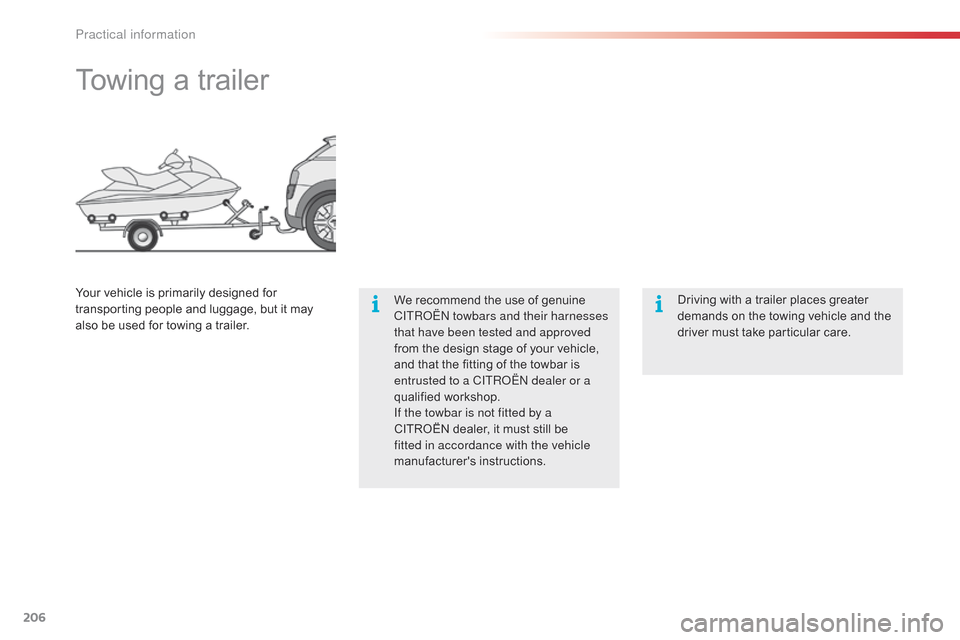
206
C4-cactus_en_Chap09_info-pratiques_ed02-2014
Towingô aô trailer
Weô recommendô theô useô ofô genuineô CITRoûn towbars and their harnesses
that have been tested and approved
from
ô the ô design ô stage ô of ô your ô vehicle, ô
a
nd ô that ô the ô fitting ô of ô the ô towbar ô is ô
e
ntrusted to a CITR
oûn
dealer or a
qualified
ô w
orkshop.
If the towbar is not fitted by a
CITROûN
ô dealer, ô it ô must ô still ô be ô
f
itted in accordance with the vehicle
manufacturer's
ô i
nstructions.
Your
ô
vehicle
ô
is
ô
primarily
ô
designed
ô
for
ô t
ransporting
ô
people
ô
and
ô
luggage,
ô
but
ô
it
ô
may
ô
a
lso
ô
be
ô
used
ô
for
ô
towing
ô
a
ô
trailer. Driving
ô with ô a ô trailer ô places ô greater ô d
emands ô on ô the ô towing ô vehicle ô and ô the ô
d
river ô must ô take ô particular ô care.
Practical information
Page 209 of 326
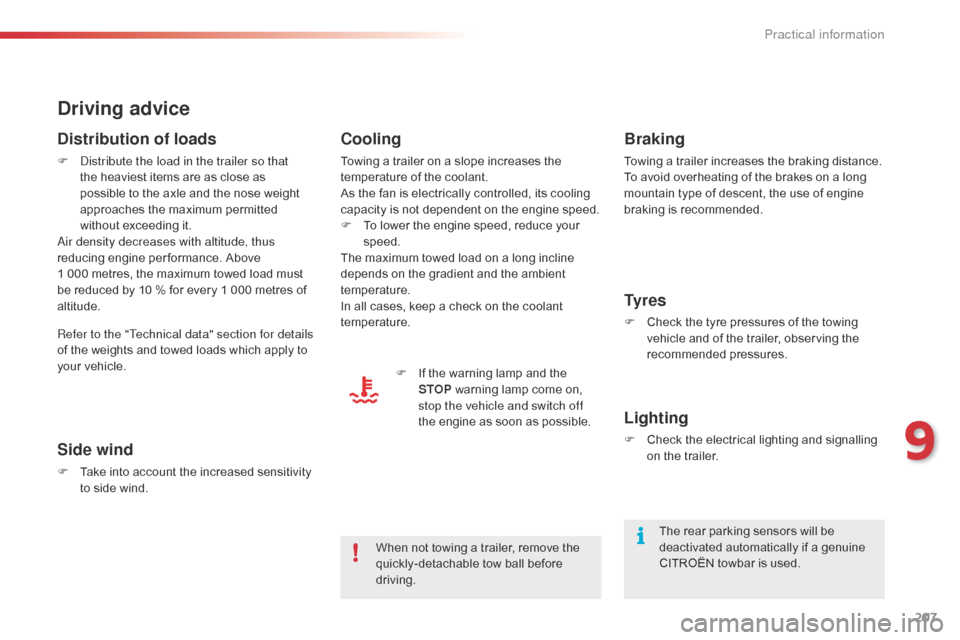
207
C4-cactus_en_Chap09_info-pratiques_ed02-2014
Driving advice
Distribution of loads
F distribute the load in the trailer so that theô heaviest ô items ô are ô as ô close ô as ô
p
ossible ô to ô the ô axle ô and ô the ô nose ô weight ô
a
pproaches ô the ô maximum ô permitted ô
w
ithout ô exceeding ô it.
ai
r density decreases with altitude, thus
reducing
ô engine ô per formance. ô Above ô
1ô 0
00ô metres, ô the ô maximum ô towed ô load ô must ô
b
e ô reduced ô by ô 10ô % ô for ô every ô 1ô 000 ô metres ô of ô
al
titude.
Side wind
Fô Take ô into ô account ô the ô increased ô sensitivity ô t
o ô side ô wind.
Cooling
Towingô aô trailerô onô aô slopeô increasesô theô temperature ô of ô the ô coolant.
As
ô the ô fan ô is ô electrically ô controlled, ô its ô cooling ô
c
apacity ô is ô not ô dependent ô on ô the ô engine ô speed.
F
ô
T
o ô lower ô the ô engine ô speed, ô reduce ô your ô
s
peed.
The
ô maximum ô towed ô load ô on ô a ô long ô incline ô
d
epends ô on ô the ô gradient ô and ô the ô ambient ô
t
emperature.
In
ô all ô cases, ô keep ô a ô check ô on ô the ô coolant ô
t
emperature. F
ô
I
f ô the ô warning ô lamp ô and ô the ô
S
TOP
ô
warning ô lamp ô come ô on, ô
s
top the vehicle and switch off
the
ô engine ô as ô soon ô as ô possible.
Braking
Towingô aô trailerô increasesô theô brakingô distance.
T o ô avoid ô overheating ô of ô the ô brakes ô on ô a ô long ô
m
ountain ô type ô of ô descent, ô the ô use ô of ô engine ô
b
raking ô is ô recommended.
Ty r e s
Fô Check ô the ô tyre ô pressures ô of ô the ô towing ô v
ehicle ô and ô of ô the ô trailer, ô observing ô the ô
re
commended
ô p
ressures.
Lighting
Fô Checkô the ô electrical ô lighting ô and ô signalling ô o
n ô the ô trailer.
Refer to the "Technical data" section for details
of
ô
the
ô
weights
ô
and
ô
towed
ô
loads
ô
which
ô
apply
ô
to
ô
y
our
ô
vehicle.
When
ô
not
ô
towing
ô
a
ô
trailer,
ô
remove
ô
the
ô
q
uickly-detachable
ô
tow
ô
ball
ô
before
ô
d
riving. The
ô rear ô parking ô sensors ô will ô be ô
d
eactivated ô automatically ô if ô a ô genuine ô
C
ITROûN ô towbar ô is ô used.
9
Practical information
Page 210 of 326
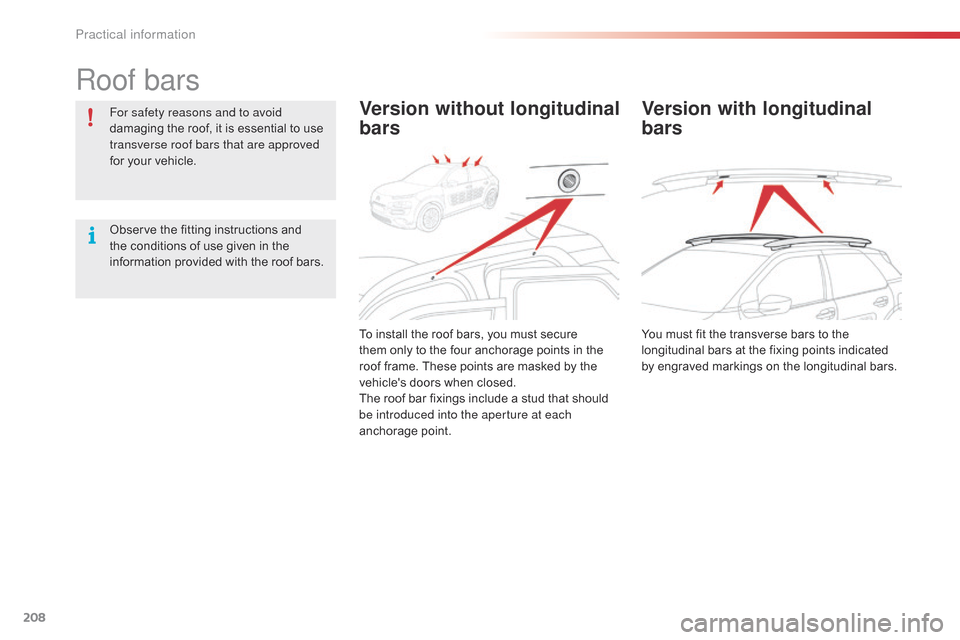
208
C4-cactus_en_Chap09_info-pratiques_ed02-2014
Roof bars
For safety reasons and to avoid
damagingô the ô roof, ô it ô is ô essential ô to ô use ô
t
ransverse roof bars that are approved
for
ô your ô vehicle.
Observe
ô the ô fitting ô instructions ô and ô
t
he ô conditions ô of ô use ô given ô in ô the ô
i
nformation ô provided ô with ô the ô roof ô bars.Version without longitudinal
bars
Toô installô theô roofô bars,ô youô mustô secureô them ô only ô to ô the ô four ô anchorage ô points ô in ô the ô
r
oof ô frame. ô These ô points ô are ô masked ô by ô the ô
v
ehicle's ô doors ô when ô closed.
The
ô roof ô bar ô fixings ô include ô a ô stud ô that ô should ô
b
e introduced into the aperture at each
anchorage
ô p
oint.
Version with longitudinal
bars
Youô mustô fitô theô transverseô barsô toô theô longitudinal ô bars ô at ô the ô fixing ô points ô indicated ô
b
y ô engraved ô markings ô on ô the ô longitudinal ô bars.
Practical information